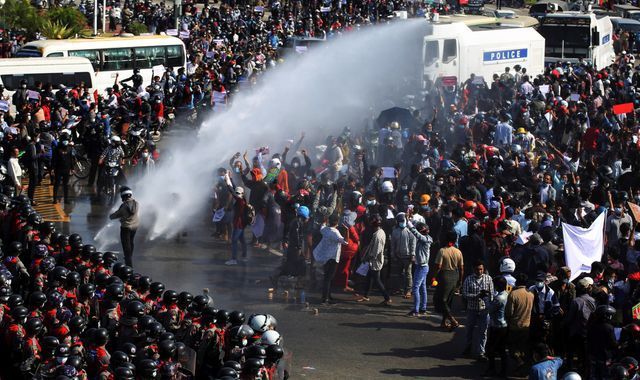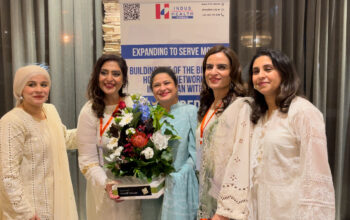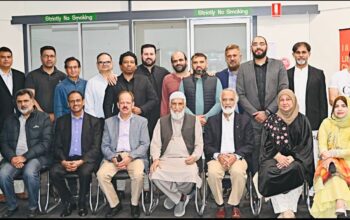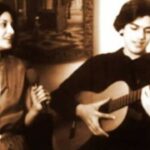Myanmar coup: Police fire rubber bullets as protesters defy ban
Police in Myanmar have fired rubber bullets during a demonstration in the capital Nay Pyi Taw, as thousands defied a ban on protests.
Water cannon and tear gas have also been used against protesters, but reports of live bullet usage are unconfirmed.
One woman is in hospital in a critical condition with a head wound.
Protesters are standing against a coup that removed the elected government last week.
It is the fourth day of consecutive protests. A ban on large public gatherings and night-time curfews have been instigated in some cities, with military leader Min Aung Hlaing warning that no-one is above the law.
The demonstrators have been demanding the release of elected leader Aung San Suu Kyi, along with senior leaders of her National League for Democracy Party (NLD). She was arrested when the military seized power.
The army has declared a year-long state of emergency and claimed, without evidence, that an earlier election was fraudulent.
How did the situation escalate?
Earlier on Tuesday, police began using water cannon against protesters in Nay Pyi Taw.
But the crowd withstood the barrage of water fired at them and refused to retreat, according to Reuters news agency.
“End the military dictatorship,” people yelled.
Warning shots were eventually fired into the air, before rubber bullets were fired at protesters.
According to BBC Burmese, who spoke to an unnamed medical officer from a Nay Pyi Taw hospital, two protesters were injured. A woman was seriously hurt from a head wound and another demonstrator had chest injuries. It is not yet clear how exactly they were wounded.
Reuters news agency also spoke with a doctor who said X-rays indicated live ammunition had been used against the woman with critical head injuries.
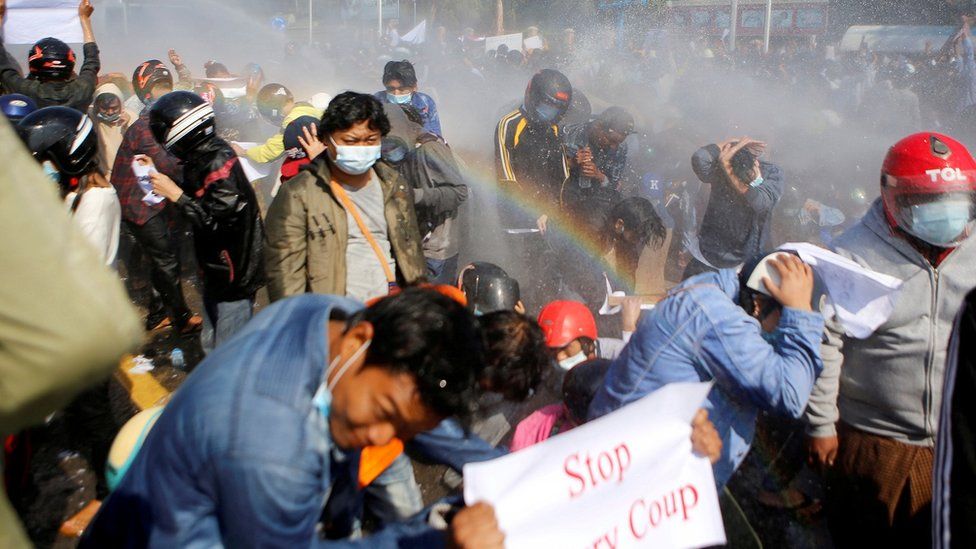 IMAGE COPYRIGHTREUTERS
IMAGE COPYRIGHTREUTERSThere are also numerous unconfirmed reports of police officers crossing over to join protesters. In some areas, police also allowed demonstrators through their barricades.
The BBC’s South East Asia correspondent Jonathan Head said it was clear officers were making a “more determined effort” to disperse protesters.
Previous protests against the country’s decades-long military rule, in 1988 and 2007, saw demonstrators killed.
What are protesters saying?
“We come here well aware of the ban over gatherings of more than five people,” one young male protester told BBC Burmese, as he gathered with others near a UN building in Yangon in a bid to boost international attention. “However, we come out because we have to protest until the president and Mother Suu are freed,” he added, referring to leader Aung San Suu Kyi, who has not been heard from since being placed under house arrest.
A female protester, who also did not want to be named, said: “Young people have their future, so we can’t tolerate this… We will keep on fighting until we get our president and Mother Suu back, whatever it takes.”
She said young protesters wanted to avoid confrontations with military, as had been seen in the past.
Even though Ms Suu Kyi’s record on human rights has previously been criticised internationally, she remains very popular in the country. Her win in the 2020 election was confirmed by various overseas monitoring bodies.
How is the military reacting?
On Monday Gen Min Aung Hlaing gave his first televised address since the coup a week earlier. He insisted the seizure of power was justified due to “voter fraud”, accusing the electoral commission of failing to investigate irregularities over voter lists in November’s election.
The commission had said there was no evidence to support claims of widespread fraud.
Ms Suu Kyi and various senior leaders from her National League for Democracy (NLD) party, including President Win Myint, were detained on 1 February.
Gen Min Aung Hlaing promised new elections overseen by a new “reformed” election commission, and said the military would hand power to the winner.

